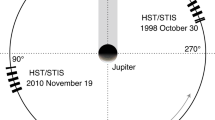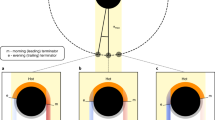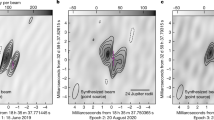Abstract
On Jupiter’s moon Io, volcanic plumes and evaporating lava flows provide hot gases to form an atmosphere that is subsequently ionized. Some of Io’s plasma is captured by the planet’s strong magnetic field to form a co-rotating torus at Io’s distance; the remaining ions and electrons form Io’s ionosphere. The torus and ionosphere are also depleted by three time-variable processes that produce a banana-shaped cloud orbiting with Io1, a giant nebula extending out to about 500 Jupiter radii2,3,4,5, and a jet close to Io6,7,8,9. No spatial constraints exist for the sources of the first two; they have been inferred only from modelling the patterns seen in the trace gas sodium observed far from Io. Here we report observations that reveal a spatially confined stream that ejects sodium only from the wake of the Io–torus interaction, together with a visually distinct, spherically symmetrical outflow region arising from atmospheric sputtering. The spatial extent of the ionospheric wake that feeds the stream is more than twice that observed by the Galileo spacecraft and modelled successfully. This implies considerable variability, and therefore the need for additional modelling of volcanically-driven, episodic states of the great jovian nebula.
This is a preview of subscription content, access via your institution
Access options
Subscribe to this journal
Receive 51 print issues and online access
$199.00 per year
only $3.90 per issue
Buy this article
- Purchase on Springer Link
- Instant access to full article PDF
Prices may be subject to local taxes which are calculated during checkout


Similar content being viewed by others
References
Smyth, W. H. & Combi, M. R. A general model for Io’s neutral gas clouds. II. Application to the sodium cloud. Astrophys. J. 328, 888–918 (1988)
Schneider, N. M. et al. Molecular origin of Io’s fast sodium. Science 253, 1394–1397 (1991)
Mendillo, M., Baumgardner, J., Flynn, B. & Hughes, J. The extended sodium nebula of Jupiter. Nature 348, 312–314 (1990)
Wilson, J. K. et al. The dual sources of Io’s sodium clouds. Icarus 157, 476–489 (2002)
Mendillo, M., Wilson, J., Spencer, J. & Stansbury, J. Io’s volcanic control of Jupiter’s extended neutral clouds. Icarus 170, 430–442 (2004)
Pilcher, C. B., Fertel, J. H., Smyth, W. H. & Combi, M. R. Io’s sodium directional features—Evidence for a magnetospheric-wind-driven gas escape mechanism. Astrophys. J. 287, 427–444 (1984)
Goldberg, B. A., Garneau, G. W. & Lavoie, S. K. Io’s sodium cloud. Science 226, 512–516 (1984)
Wilson, J. K. & Schneider, N. M. Io’s sodium directional feature: Evidence for ionospheric escape. J. Geophys. Res. 104, 16567–16584 (1999)
Burger, M. H., Schneider, N. M. & Wilson, J. K. Galileo’s close-up view of the Io sodium jet. Geophys. Res. Lett. 26, 3333–3336 (1999)
Baumgardner, J., Mendillo, M. & Wilson, J. K. A digital high definition imaging system for spectral studies of extended planetary atmospheres. 1. Initial results in white light showing features on the hemisphere of Mercury unimaged by Mariner 10. Astron. J. 119, 2458–2464 (2000)
Fried, D. L. Probability of getting a lucky short-exposure image through turbulence. J. Opt. Soc. Am. 68, 1651–1658 (1978)
Warrel, J. & Limaye, S. S. Properties of the hermean regolith: I. Global regolith albedo variation at 200 km scale from multicolor CCD imaging. Planet. Space Sci. 49, 1531–1552 (2001)
Mendillo, M. et al. Imaging the surface of Mercury using ground-based telescopes. Planet. Space Sci. 49, 1501–1505 (2001)
Laurent, S. Design of a High Definition Imaging (HDI) Analysis Technique Adapted to Challenging Environments PhD dissertation (College of Engineering, Boston University, Boston, 2004); 〈http://sirius.bu.edu/aeronomy/laurentthesis.pdf〉
Laurent, S. et al. Design of a High Definition Imaging (HDI) analysis technique adapted to challenging environments. In Applications of Digital Image Processing XXVII (ed. Tescher, A. G.) Proc. SPIE 5558, 676–687 (2004)
Linker, J. A., Kivelson, M. G. & Walker, R. J. A three-dimensional MHD simulation of plasma flow past Io. J. Geophys. Res. 96, 21037–21053 (1991)
Saur, J., Neubauer, F. M., Strobel, D. F. & Summers, M. E. Three-dimensional plasma simulation of Io’s interaction with the Io plasma torus: Asymmetric plasma flow. J. Geophys. Res. 104, 25105–25126 (1999)
Combi, M. R., Kabin, K., Gombosi, T. I., DeZeeuw, D. L. & Powell, K. G. Io’s plasma environment during the Galileo flyby: Global three-dimensional MHD modeling with adaptive mesh refinement. J. Geophys. Res. 103, 9071–9082 (1998)
Kabin, K. et al. Io’s magnetospheric interaction: an MHD model with day-night asymmetry. Planet. Space Sci. 49, 337–344 (2001)
Frank, L. A. et al. Plasma observations at Io with the Galileo spacecraft. Science 274, 394–395 (1996)
Hinson, D. P. et al. Galileo radio occultation measurements of Io’s ionosphere and plasma wake. J. Geophys. Res. 103, 29343–29357 (1998)
Kuppers, M. & Schneider, N. M. Discovery of chlorine in the Io torus. Geophys. Res. Lett. 27, 513–516 (2000)
Lellouch, E., Paubert, G., Moses, J. J., Schneider, N. M. & Strobel, D. F. Volcanically emitted sodium chloride as a source for Io’s neutral clouds and plasma torus. Nature 42, 45–47 (2003)
Zolotov, M. & Fegley, B. Eruption conditions of Pele volcano on Io inferred from chemistry of its volcanic plume. Geophys. Res. Lett. 27, 2789–2792 (2000)
Moses, J. J., Zolotov, M. & Fegley, B. Alkali and chlorine photochemistry in a volcanically driven atmosphere on Io. Icarus 156, 107–135 (2002)
Wilson, J. K. & Mendillo, M. A change in Io’s sodium clouds during the Cassini/Jupiter flyby. Eos 82, S255 (2001)
Burger, M. H. et al. Mutual event observations of Io’s sodium corona. Astrophys. J. 563, 1063–1074 (2001)
Acknowledgements
We thank P. Kervin and staff of the AEOS installation for their expertise and collegiality in the use of our HDI system for these measurements. The Boston University HDI image slicer was built under a Defense University Research Instrumentation Program (DURIP) grant via sponsorship by the Office of Naval Research (ONR). Observations were made possible by a grant from the joint NSF/AFOSR programme for AEOS, and data analysis was funded by a grant from the NSF Planetary Astronomy Program.
Author Contributions The observations were made by J.B., J.W. and M.M., who also guided the overall study. S.L. developed the HDI techniques and conducted the data analysis with methodological expertise provided by J.K, W.C.K., J.B. and J.W. M.M. wrote most of the paper, with contributions and interpretation of the data from J.W. and J.B.
Author information
Authors and Affiliations
Corresponding author
Ethics declarations
Competing interests
Reprints and permissions information is available at www.nature.com/reprints. The authors declare no competing financial interests.
Rights and permissions
About this article
Cite this article
Mendillo, M., Laurent, S., Wilson, J. et al. The sources of sodium escaping from Io revealed by spectral high definition imaging. Nature 448, 330–332 (2007). https://doi.org/10.1038/nature06000
Received:
Accepted:
Issue Date:
DOI: https://doi.org/10.1038/nature06000
This article is cited by
-
Ab Initio Study of Electronic States of Astrophysically Important Molecules
Russian Physics Journal (2016)
-
Atmospheric/Exospheric Characteristics of Icy Satellites
Space Science Reviews (2010)
-
Energy Deposition in Planetary Atmospheres by Charged Particles and Solar Photons
Space Science Reviews (2008)
Comments
By submitting a comment you agree to abide by our Terms and Community Guidelines. If you find something abusive or that does not comply with our terms or guidelines please flag it as inappropriate.



